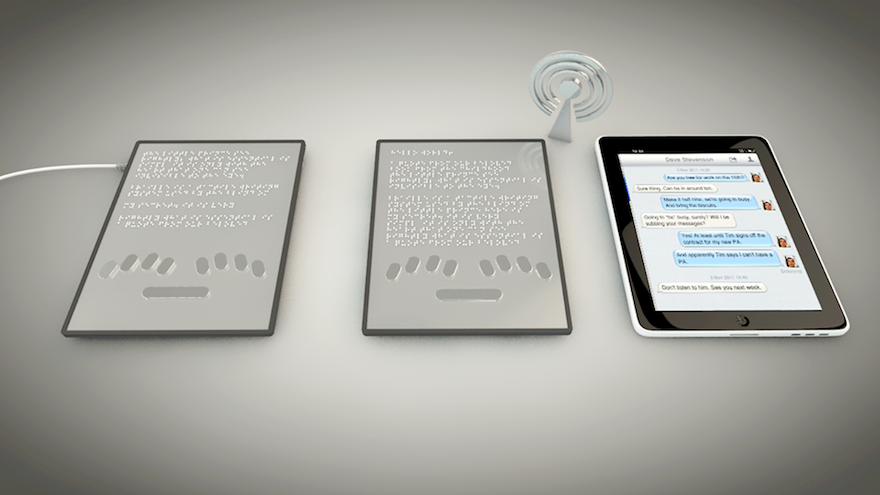Empowering Independence With Assistive Innovation for the Blind
The assimilation of assistive technology right into the lives of people with visual impairments represents a substantial advancement in promoting self-reliance and self-sufficiency. From cutting-edge display readers to advanced wise walking canes, these devices not only enhance day-to-day navigation and interaction yet additionally empower users to engage meaningfully in different facets of life. As we discover the myriad advantages and real-world applications of these technologies, it ends up being vital to check out the hidden factors that contribute to their effectiveness and the capacity for future advancements in this important field.
Introduction of Assistive Modern Technology

The development of assistive technology is grounded in principles of inclusivity and empowerment. Innovations in software, hardware, and sensory enhancements provide users with options tailored to their specific demands. From display viewers that transform message to speech, to responsive gadgets that communicate info via touch, these tools transform the means people involve with their environments.
Along with functional applications, assistive modern technology promotes better social incorporation and engagement in different markets, including education and work (Screen readers for the blind). As r & d remain to progress, the potential for assistive innovation to even more boost the lives of visually damaged individuals continues to be appealing, paving the means for a much more fair culture where everyone can grow
Types of Assistive Devices
A range of assistive devices have actually emerged to sustain individuals with aesthetic impairments, each made to satisfy details requirements and enhance everyday functioning. These gadgets vary from low-tech services to high-tech technologies, offering varied options for individuals.
Low-tech devices include magnifiers and large-print products that assist in analysis and writing. Braille devices, such as Braille slates and styluses, enable responsive analysis and communication. Positioning and movement help, like white canes, assist customers navigate their atmosphere securely.
On the greater end of the spectrum, electronic zoom systems and display readers use substantial assistance. Digital magnifiers permit individuals to increase the size of text and pictures on displays, while display viewers convert digital material right into manufactured speech, facilitating access to info on smartphones and computers.
Mobile phone applications additionally play an important duty, providing attributes like text recognition and navigation support. Wearable innovation, such as wise glasses furnished with increased fact, is becoming an encouraging device to boost situational recognition.
Benefits of Assistive Technology
The integration of assistive technology considerably enhances the lifestyle for individuals with visual impairments. These technologies empower users by promoting independence, allowing them to browse their settings better and do day-to-day jobs with higher ease. Screen viewers and zoom software application allow people to accessibility digital information, cultivating professional and educational possibilities that might have previously been out of reach.
Furthermore, assistive tools such as wise canes and general practitioners applications supply real-time navigation aid, improving movement and safety. This raised autonomy not just improves self-worth however additionally motivates social engagement, enabling users to get involved more completely in their communities.
Assistive modern technology also promotes communication, assisting users link with others through voice recognition and text-to-speech applications. This capacity is important for keeping relationships and accessing important information.
Furthermore, the customization choices readily available with numerous assistive innovations ensure that individuals can customize tools to their particular requirements, better enhancing functionality and performance. Overall, the benefits of assistive innovation for people with aesthetic impairments are profound, promoting an extra comprehensive society where everyone can pursue their objectives and desires.
Study and Success Stories
Highlighting the transformative effect of assistive technology, numerous study show how individuals with aesthetic disabilities have efficiently incorporated these tools right into their day-to-days live. One Smart glasses for the visually impaired engaging example involves an university student who utilized display reading software to browse online sources and academic products successfully. This technology not just facilitated her education however also boosted her confidence in taking part in conversations and team projects.
An additional situation study features a professional that employs a smart device application developed for navigating and object acknowledgment. By using this application, he has gained back autonomy in both his individual and workplace, permitting him to commute separately and involve with colleagues better.
In addition, a retiree shared her experience with braille e-readers, which allowed her to access a vast variety of literary works and stay attached with her area with publication clubs.
These success tales underscore the vital role of assistive innovation in cultivating independence, enhancing high quality of life, and advertising social integration for individuals with visual problems (Smart glasses for the visually impaired). By accepting these cutting-edge devices, users can overcome difficulties and take possibilities that add to their professional and personal satisfaction

Future Patterns in Assistive Modern Technology
Development in assistive modern technology is poised to redefine the landscape of assistance for people with aesthetic impairments. Emerging fads emphasize the assimilation of expert system (AI) and equipment knowing, which boost the functionality of gadgets that aid with navigating and information availability. AI-driven applications are now qualified of analyzing aesthetic information in real-time, enabling users to engage with their atmosphere extra independently.
Additionally, the advancement of wearable modern technology is progressing quickly. Smart glasses geared up with enhanced truth (AR) can offer audio descriptions of environments, changing just how customers connect with public rooms. These tools not just advertise autonomy but also foster social incorporation.
In Addition, the Web of Things (IoT) is making homes smarter, enabling seamless connection in between assistive devices and everyday devices. This connection equips individuals by allowing automatic reactions and voice-activated controls customized to private needs.
Verdict
To conclude, assistive technology plays a crucial function in empowering people with visual disabilities by enhancing their freedom and engagement with their surroundings. The diverse range of applications and tools offered not only promotes navigation and interaction but likewise advertises social combination and possibilities for personal and specialist development. As developments proceed in this field, the capacity for boosting the lifestyle for those with aesthetic problems will increase, promoting better freedom and empowerment.
